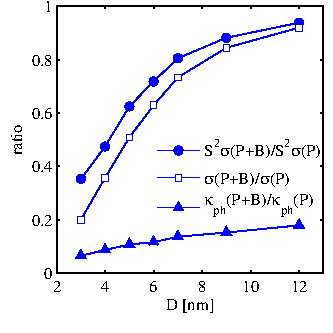The reason why boundary scattering degrades the thermal conductivity more than
the electrical conductivity is that the electronic system is not affected significantly by boundary scattering for larger nanowire diameters, i.e.
![]() . In the absence of a confining electric field (e.g. flat potential in the nanowires' cross section), electron scattering by surface roughness depends mainly on the shift of the band edges due to confinement, which is only important for diameters
. In the absence of a confining electric field (e.g. flat potential in the nanowires' cross section), electron scattering by surface roughness depends mainly on the shift of the band edges due to confinement, which is only important for diameters
![]() . On the other hand, from Eq. 5.2, the phonon-boundary scattering rate is inversely proportional to the nanowire diameter as
. On the other hand, from Eq. 5.2, the phonon-boundary scattering rate is inversely proportional to the nanowire diameter as ![]() , a trend that is initiated at very large diameters. At
, a trend that is initiated at very large diameters. At
![]() the thermal conductivity is already strongly reduced. Although the surface-roughness scattering-limited electron mobility degrades strongly with a power factor of
the thermal conductivity is already strongly reduced. Although the surface-roughness scattering-limited electron mobility degrades strongly with a power factor of ![]() for
for
![]() [146], the overall reduction of the electrical conductivity is less than
the
[146], the overall reduction of the electrical conductivity is less than
the
![]() reduction even for diameters down to
reduction even for diameters down to
![]() .
.

|
This stronger reduction of the thermal conductivity due to boundary scattering
compared to the reduction of the electrical conductivity due to boundary scattering, is
illustrated in Fig. 6.4. Here we show the ratio of the thermal conductivity for the
![]() nanowires including phonon-phonon and phonon-boundary scattering (
nanowires including phonon-phonon and phonon-boundary scattering (
![]() ), to the thermal conductivity including only phonon-phonon scattering (
), to the thermal conductivity including only phonon-phonon scattering (
![]() ) (triangle symbols). We also show the same ratio for the electrical conductivity of the
) (triangle symbols). We also show the same ratio for the electrical conductivity of the ![]() -type nanowires, e.g. the ratio of the electrical conductivity including electron-phonon-plus-SRS, to the electrical conductivity including only electron-phonon scattering (empty-square symbols). The figure clearly demonstrates that although the degradation in the electrical conductivity due to SRS becomes stronger as the diameter is reduced, still, the detrimental effect of boundary scattering is larger on the thermal conductivity. Even at the relatively large nanowire diameters
-type nanowires, e.g. the ratio of the electrical conductivity including electron-phonon-plus-SRS, to the electrical conductivity including only electron-phonon scattering (empty-square symbols). The figure clearly demonstrates that although the degradation in the electrical conductivity due to SRS becomes stronger as the diameter is reduced, still, the detrimental effect of boundary scattering is larger on the thermal conductivity. Even at the relatively large nanowire diameters
![]() , phonon-boundary scattering is very effective in reducing the thermal conductivity down to
, phonon-boundary scattering is very effective in reducing the thermal conductivity down to ![]() of its phonon-phonon scattering-limited value. Additionally, the power factor, benefits from an increase in the Seebeck coefficient by diameter reduction and surface-roughness-scattering by
of its phonon-phonon scattering-limited value. Additionally, the power factor, benefits from an increase in the Seebeck coefficient by diameter reduction and surface-roughness-scattering by ![]() [147]. This improves the power factor, which partly compensates the reduction of the electrical conductivity as also shown in Fig. 6.4 (circle symbols).
[147]. This improves the power factor, which partly compensates the reduction of the electrical conductivity as also shown in Fig. 6.4 (circle symbols).